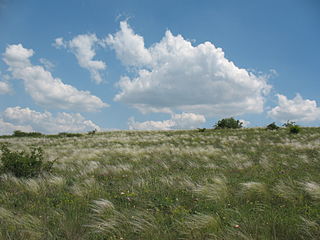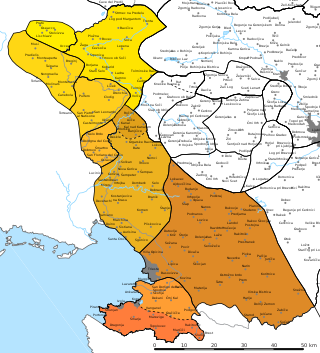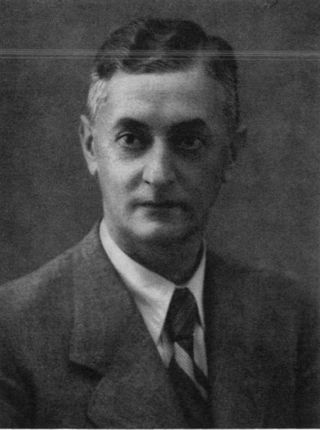The ruki sound law, also known as the ruki rule or iurk rule, is a historical sound change that took place in the satem branches of the Indo-European language family, namely in Balto-Slavic, Armenian, and Indo-Iranian. According to this sound law, an original *s changed to *š after the consonants *r, *k, *g, *gʰ and the semi-vowels *w (*u̯) and *y (*i̯), as well as the syllabic allophones *r̥, *i, and *u:

Kajkavian is a South Slavic supradialect or language spoken primarily by Croats in much of Central Croatia and Gorski Kotar.

*Dyḗus, also *Dyḗus ph₂tḗr, is the reconstructed name of the daylight-sky god in Proto-Indo-European mythology. *Dyēus was conceived as a divine personification of the bright sky of the day and the seat of the gods, the *deywṓs. Associated with the vast diurnal sky and with the fertile rains, *Dyēus was often paired with *Dʰéǵʰōm, the Earth Mother, in a relationship of union and contrast.
In Indo-European linguistics, the term Indo-Hittite refers to Edgar Howard Sturtevant's 1926 hypothesis that the Anatolian languages may have split off a Pre-Proto-Indo-European language considerably earlier than the separation of the remaining Indo-European languages. The term may be somewhat confusing, as the prefix Indo- does not refer to the Indo-Aryan branch in particular, but is iconic for Indo-European, and the -Hittite part refers to the Anatolian language family as a whole.
An etymological dictionary discusses the etymology of the words listed. Often, large dictionaries, such as the Oxford English Dictionary and Webster's, will contain some etymological information, without aspiring to focus on etymology.

Indo-Uralic is a controversial hypothetical language family consisting of Indo-European and Uralic.
Studies in Slavic and General Linguistics (SSGL) is an academic book series that was founded in 1980 by A.A. Barentsen, B.M. Groen and R. Sprenger and is published by Rodopi.
Ranko Matasović is a Croatian linguist, Indo-Europeanist and Celticist.
The Indo-European Etymological Dictionary is a research project of the Department of Comparative Indo-European Linguistics at Leiden University, initiated in 1991 by Peter Schrijver and others. It is financially supported by the Faculty of Humanities and Centre for Linguistics of Leiden University, Brill Publishers, and the Netherlands Organisation for Scientific Research.
Numerous lexemes that are reconstructable for Proto-Slavic have been identified as borrowings from the languages of various tribes that Proto-Slavic speakers interacted with in either prehistoric times or during their expansion when they first appeared in history in the sixth century. Most of the loanwords come from Germanic languages, with other contributors being Iranian, Celtic, and Turkic. Slavic loanwords sparked numerous debates in the 20th century, some of which persist today.

Marko Snoj is an Indo-Europeanist, Slavist, Albanologist, lexicographer, and etymologist employed at the Fran Ramovš Institute for Slovene Language of the Scientific Research Center of the Slovenian Academy of Sciences and Arts in Ljubljana, Slovenia. He served as director of the institute from 2008 to 2018. He has made numerous scholarly contributions to Indo-European linguistics, particularly in the realms of Slovene and Albanian, and is noted for his work in advancing Slavic etymology in both scholarly and popular domains. He is a full fellow of the Slovenian Academy of Sciences and Arts.
Jay Harold Jasanoff is an American linguist and Indo-Europeanist, best known for his h2e-conjugation theory of the Proto-Indo-European verbal system. He teaches Indo-European linguistics and historical linguistics at Harvard University.
Rick Derksen is a Dutch linguist and Indo-Europeanist at the University of Leiden who specializes in Balto-Slavic historical linguistics with an emphasis on accentology and etymology.
Michiel Arnoud Cor de Vaan is a Dutch linguist and Indo-Europeanist. He taught comparative Indo-European linguistics, historical linguistics and dialectology at the University of Leiden until 2014, when he moved to the University of Lausanne in Switzerland. De Vaan had been at the University of Leiden since 1991, first as a student and later as a teacher.
The Gail Valley dialect is the westernmost Slovene dialect in the Carinthian dialect group, spoken in parts of southern Carinthia in Austria, in the northeasternmost part of the Province of Udine in Italy, and in northeastern Upper Carniola in Slovenia.

This article uses Logar transcription.

The Natisone Valley dialect, or Nadiža dialect, is a Slovene dialect spoken mainly in Venetian Slovenia, but also in a small part of Slovenia. It is one of the two dialects in the Littoral dialect group to have its own written form, along with Resian. It is closely related to the Torre Valley dialect, which has a higher degree of vowel reduction but shares practically the same accented vowel system. It borders the Torre Valley dialect to the northwest, the Soča dialect to the northeast, the Karst dialect to the southeast, the Brda dialect to the south, and Friulian to the west. The dialect belongs to the Littoral dialect group, and it evolved from Venetian–Karst dialect base.

Fran Ramovš was a Slovenian linguist. He studied the dialects and onomastics of Slovene.
Mate Kapović is a Croatian linguist specializing in Indo-European, Slavic languages and the Proto-Balto-Slavic language. He studied Croatian language and linguistics at the Faculty of Arts of University of Zagreb. He graduated in 2003 and he has been teaching at the same university since 2004. In 2007, he obtained his doctorate at the Faculty of Philosophy of University of Zadar.
Sergei Lvovich Nikolaev is a Soviet and Russian linguist, specialist in comparative historical linguistics, Slavic accentology and dialectology. He is the author of a number of books and articles on Indo-European studies, accentology, and Slavic dialectology. Nikolaev is Doctor Nauk in Philological Sciences.





